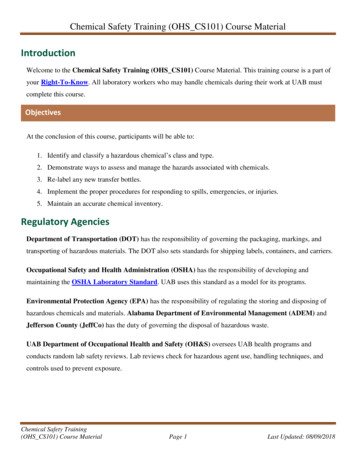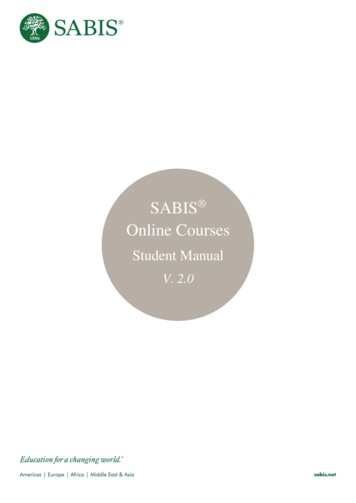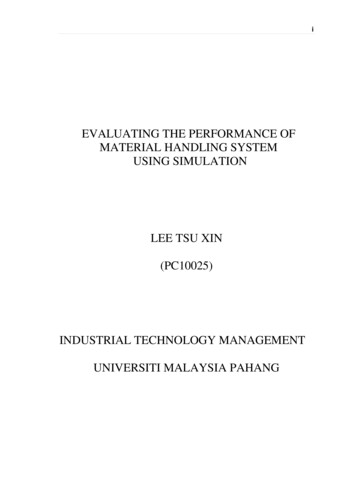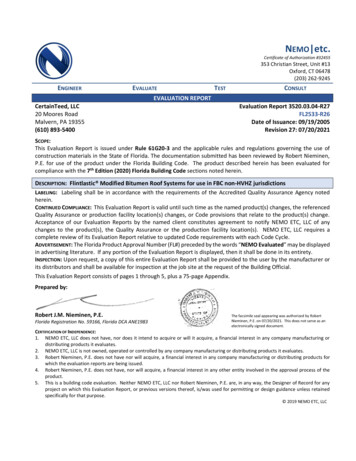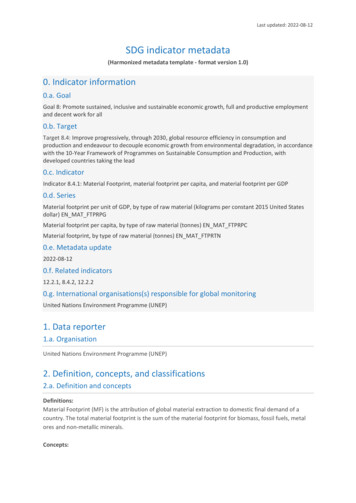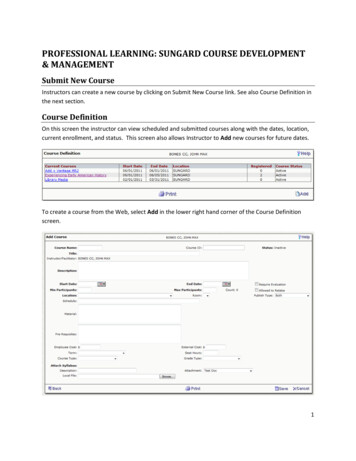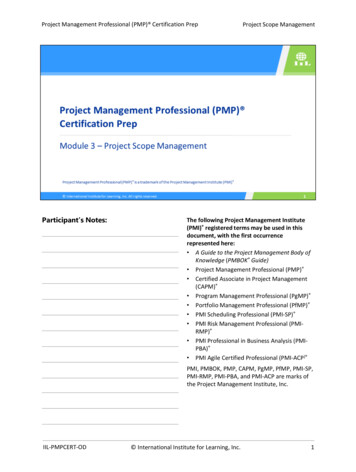
Transcription
A Course Material onPROFESSIONAL ETHICS INENGINEERINGByMS.UMAASSISTANT PROFESSORDEPARTMENT OF SCIENCE & HUMANITIESPRATHYUSHA ENGINEERING COLLEGE
GE8076S.NoPROFESSIONAL ETHICS IN ENGINEERINGCONTENTSPAGE NOUNIT I ENGINEERING ETHICS1.1Senses of Engineering Ethics011.2Kohlberg and Gilligan‟s theory021.3Moral dilemmas.061.5Morality and Moral issues081.6Moral autonomy101.7Consensus and Controversy111.9Uses of Ethical Theories141.10Professional Ideals and Virtues15UNIT-IIENGINEERING AS SOCIAL EXPERIMENTATION2.1Ethics and positive roles of code of ethics182.2Engineering experiments with standard experiments192.3Engineers as responsible experimenters20UNIT-III ENGINEER’S RESPONSIBILITY FOR SAFETY3.1Safety and risk233.2Risk assessment243.3Risk benefit analysis253.4Bhopal gas tragedy263.5Difficulties in establishing safeguards26UNIT – IV DIGITAL MODULATION SCHEME4.1Collegiality and loyalty284.2Collective bargaining and occupational crime294.3Intellectual property rights30Page 1
GE 8076PROFESSIONAL ETHICS IN ENGINEERING4.44.5Employee rights31The employee role of confidentiality32UNIT-V GLOBAL ISSUES5.1Multinational corporations with neat example345.2Computer ethics is the technological background of the society355.3Environmental ethics through engineering ecology and economics375.4Human-centered ethics405.5Involvement in weapons work425.6Honesty43APPENDICESAQuestion Bank46BUniversity Question Papers48Page 2
GE 8076GE 8076PROFESSIONAL ETHICS IN ENGINEERINGPROFESSIONAL ETHICS IN ENGINEERINGUNIT I ENGINEERING ETHICS9Senses of „Engineering Ethics‟ – Variety of moral issues – Types of inquiry – Moraldilemmas – Moral Autonomy – Kohlberg‟s theory – Gilligan‟s theory – Consensus andControversy – Professions and Professionalism – Professional Ideals and Virtues –Uses of Ethical TheoriesUNIT II ENGINEERING AS SOCIAL EXPERIMENTATION9Engineering as Experimentation – Engineers as responsible Experimenters – ResearchEthics - Codes of Ethics – Industrial Standards - A Balanced Outlook on Law – TheChallenger Case StudyUNIT III ENGINEER’S RESPONSIBILITY FOR SAFETY9Safety and Risk – Assessment of Safety and Risk – Risk Benefit Analysis – ReducingRisk – The Government Regulator‟s Approach to Risk - Chernobyl Case Studies andBhopalUNIT IV RESPONSIBILITIES AND RIGHTS9Collegiality and Loyalty – Respect for Authority – Collective Bargaining – Confidentiality– Conflicts of Interest – Occupational Crime – Professional Rights – Employee Rights –Intellectual Property Rights (IPR) – DiscriminationUNIT V GLOBAL ISSUES9Multinational Corporations – Business Ethics - Environmental Ethics – Computer Ethics Role in Technological Development – Weapons Development – Engineers as Managers– Consulting Engineers – Engineers as Expert Witnesses and Advisors – Honesty –Moral Leadership – Sample Code of ConductTOTAL :45 PERIODSTEXT BOOKS1. Mike Martin and Roland Schinzinger, “Ethics in Engineering”, McGraw Hill, New York,2005.2. Charles E Harris, Michael S Pritchard and Michael J Rabins, “Engineering Ethics –Concepts and Cases”, Thompson Learning, 2000.REFERENCES1. Charles D Fleddermann, “Engineering Ethics”, Prentice Hall, New Mexico, 1999.2. John R Boatright, “Ethics and the Conduct of Business”, Pearson Education, 20033. Edmund G Seebauer and Robert L Barry, “Fundamentals of Ethics for Scientists andEngineers”, Oxford University Press, 2001.4. Prof. (Col) P S Bajaj and Dr. Raj Agrawal, “Business Ethics – An IndianPerspective”, Biztantra, New Delhi, 2004.5. David Ermann and Michele S Shauf, “Computers, Ethics and Society”, OxfordUniversity Press, (2003)Page 3
GE 8076PROFESSIONAL ETHICS IN ENGINEERINGPage 4
GE 8076PROFESSIONAL ETHICS IN ENGINEERINGUNIT -1 (ENGINEERING ETHICS)OVERVIEWEngineering Ethics is the activity and discipline aimed at(a) understanding the moral values that ought to guide engineering profession or practice,(b) resolving moral issues in engineering, and(c) justifying the moral judgments in engineering. It deals with set of moral problems and issuesconnected with engineering.Engineering ethics is defined by the codes and standards of conduct endorsed byengineering (professional) societies with respect to the particular set of beliefs, attitudes andhabits displayed by the individual or group. Another important goal of engineering ethics is thediscovery of the set of justified moral principles of obligation, rights and ideals that ought to beendorsed by the engineers and apply them to concrete situations. Engineering is the largestprofession and the decisions and actions of engineers affect all of us in almost all areas of ourlives, namely public safety, health, and welfare.ScopeThe scopes of engineering ethics are twofold:1. Ethics of the workplace which involves the co-workers and employees in an organization.2. Ethics related to the product or work which involves the transportation, warehousing, anduse, besides the safety of the end product and the environment outside the factory.ApproachThere are conventionally two approaches in the study of ethics:1. Micro-ethics which deals with decisions and problems of individuals, professionals, andcompanies.2. Macro-ethics which deals with the societal problems on a regional/national level. Forexample, global issues, collective responsibilities of groups such as professional societies andconsumer groups.1.1 SENSES OF ENGINEERING ETHICS:There are two different senses (meanings) of engineering ethics, namely the Normative and theDescriptive senses. The normative sense includes:(a) Knowing moral values, finding accurate solutions to moral problems and justifyingmoral judgments in engineering practices,(b) Study of decisions, policies, and values that are morally desirable in the engineering practiceand research, and(c) Using codes of ethics and standards and applying them in their transactions by engineers. Thedescriptive sense refers to what specific individual or group of engineers believe an act, withoutjustifying their beliefs or actions.SCE1ECE
GE 8076PROFESSIONAL ETHICS IN ENGINEERING1.2 KOHLBERG AND GILLIGAN VIEWS:Kohlberg TheoryThese theories are based on the sorts of reasoning and motivation adopted by individualswith regard to moral questions.Lawrence Kohlberg‟s Theory According to Kohlberg, the people progressed in their moral reasoning through a series ofstages. His theory is based on the foundation that morality is a form of reasoning thatdevelops I structural stages.The three levels of moral development, suggested by Kohlberg, are:1. Pre-conventional level;2. Conventional level; and3. Post –conventional level.1. Pre- conventional level The pre-conventional level of moral development is based to derive benefits for oneself.In the first level, individual behave according to socially acceptable norms, which are taughtmainly by parents and teachers.At this level, individuals are motivated mainly by their interest to avoid punishment, or bytheir desire to satisfy their own needs, or by the external power exerted on them.This is the level of development of all young children and some adults, who are unable toreach beyond a certain limit.2. Conventional level In the second level, the moral thinking and behavior of the individual aredetermined by the standards of their family, community, and society. That is, thenorms or customs of one‘s family/community/society are accepted and adopted asthe ultimate standard of morality.At this level, individuals are motivated by the desire to please others and to meet thesocial units‘ expectations, without bothering much about their self-interest.Thus as per the second level, individuals give more importance to loyalty and closeidentification with others, than their own self-interest.Many studies of Kohlberg reveal that most adults are living at this level only.The second level of moral thinking is found in society generally. That‘s why it is namedas ‗conventional‘ level of moral development3. Post –Conventional level SCEIn the post-conventional level, the individuals are guided by strong principles andconvictions, not by selfish needs or pressures from society.2ECE
GE 8076PROFESSIONAL ETHICS IN ENGINEERING According to Kohlberg, these individuals are called as ‗autonomous‘, becausethey think for/by themselves and also they do not believe that customs are alwaysright.The people at this level want to live by general principles that are universallyapplied to all people. They always desire to maintain their moral integrity, selfKohlberg felt that the majority of adults do not reach the post-conventional level.Gilligan Theory Carol Gilligan, a former student and colleague of Kohlberg, has criticizedKohlberg‘s theory as male blased.She also charged Kohlberg that Kohlberg‘s studies were concluded with malesamples only and also his approach is dominated by a typical preoccupation withgeneral rules and rights.According to Gilligan, males have tendency to over-ride the importance of moralrules and convictions while resolving moral dilemmas; whereas females havetendency to try hard to preserve personal relationships with all people invlolved ina situation.Also Gilligan felt that men mostly focus their attention on content of the problem,whereas women focus their attention on the context i.e., situation of the problem.Gilligan refers her context-oriented emphasis on maintaining personalrelationships as the ethics of care, and contrasts it with Kohlberg‘s ethics of rulesand rights.Gilligan‟s Levels Of Moral Development1. Pre-conventional level This is almost the same as Kohlberg‘s first level.That is, in this level an individual is concerned with self-centered reasoning.2. Conventional level This level differs from Kohlberg‘s second level.According to Gilligan, women will not hurt others and have a willingness to sacrifice theirown interests in order to help others.3. Post-conventional level SCEThis level also differs from Kohlberg‘s third level.In this level, the individual is able to maintain balance between his own needs with the needsof others.3ECE
GE 8076PROFESSIONAL ETHICS IN ENGINEERING The balancing can be achieved through context-oriented reasoning i.e., examiningall facts, people and circumstances involved, rather than by applying abstract rulesranked in a hierarchy of importance.1.3 ACT AND RULE UTILITARIAN:Theory of human rights ethics The rights ethicists emphasize that any action that violates any moral right is considered asethically unacceptable.This theory holds that those actions are good that respect the rights of the individual.In other words, rights ethics holds that people have fundamental rights that other people have a duty torespect.Two versions of right ethics are:1. Locke‘s version of rights ethics, and2. Meldon‘s version of right ethicsLocke‟s version of rights ethics John locke (163-1704) a famous rights ethicist, argued that humans have human rights to life,liberty, and the property generated by one‘s labor.His views human rights either were considered as highly individualistic.In locke‘s view, rights are claims that prevent other people from interfering in one‘s life.These rights are referred as ‗liberty rights‘ or ‗negative rights‘ that place duties on otherpeople not to interfere with one‘s life.Melden‟s version of rights ethics Melden (1910-1991) considered human rights as intimately related to communities of people.According to Melden, moral rights require the capacity to show concern for other and to beaccountable within a moral community.Melden also defined welfare rights as rights to community benefits needed living a minimumdecent human life.Similarities between duty ethics and rights ethics In fact, duty ethics and right ethics are like two different sides of the same coin.SCE4ECE
GE 8076 PROFESSIONAL ETHICS IN ENGINEERINGBoth the theories focus and achieve the same end result. The end result is that individualpersons must be respected, and actions are ethical that maintain this respect for theindividual.As per duty ethics, people have duties, a primary one of which is to protect the rights of others.But according to right ethics, people have fundamental rights that others have duties to protect.Difficulties in implementing duty and rights ethics theoriesThe two principal difficulties with the duty and rights ethics theories are: It is sometimes very difficult to prioritize the rights of individuals or groups. Because thebasic rights of an individual or groups of individuals may conflict with the basic rights ofanother group.Since both the theories concern more about the good of an individual, therefore sometimes theoverall good of society is not given much importance.Tests for evaluating ethical theories Theory must be clear and logical. The concepts of theory should be formulated to enhanceapplicability.The theory should be consistent with its principles. The principles of the same theory should notcontradict each other.The theory and its defense should rely only upon facts, truths, and correct information.The theory should be adequately complete so that to provide guidance for our required specificsituations.The theory should be well- matched with moral convictions such as judgments, and intuitionsabout concrete situations.What is meant by utility?Utility can be defined as an overall balance between good and bad consequences of anaction, taking into account the consequences for everyone affected.Rule utilitarianism Rule utilitarianism differs from act utilitarianism in owning that moral rules are more importantthan an individual‘s action.Richard Brandt proposed this version of utilitarianism.According to Brandt, though sticking to general moral rules such as don‘t lie, don‘t steal,be honest, don‘t harm others, etc might not always maximize good in a particularsituation, overall, sticking to moral rules will ultimately guide to the most good.Act utilitarianism The act utilitarianism concept was developed by John Stuart Mill.(180-1873).The act utilitarianism focuses on individual actions rather than on general rules.It is understood that most of the common rules of morality such s don‘t lie, don‘t steal, be honest,don‘t harm others, keep promises etc are good guidelines to judge a human begin.But according to Mill, a person‘s actions should be judged based on whether the greatestgood was achieved in a given situation. He also emphasized that even the general rulesshould be broken, if necessary, to achieve the greatest good for the greatest number ofpeople.SCE5ECE
GE 8076 PROFESSIONAL ETHICS IN ENGINEERINGMill‟s view about „goodness‟As we know, the standard of right action is maximizing goodness, according to Mill, theterm ‗goodness‘ represents two things.Intrinsic good: intrinsic good is something good in and of itself, or desirable for its ownsake. He felt that happiness is the only intrinsic good.Instrumental goods: instrumental goods are other good things that provide means forhappiness.In Mill‘s view, the pleasures derived through intellectual inquiry, creativeaccomplishment, appreciation of beauty, friendship, and love are inherently better thanthe bodily pleasures derived from eating, sex, and exercise.1.4 MORAL DILEMMA:What are moral dilemmas? Moral dilemmas are situations in which two or more moral obligations, duties, rights, goods, orideals come into conflict with each other.The crucial feature of a moral dilemma is that all the moral principles cannot be fully respected ina given situation.Also solving one moral principle can create two or more conflicting applications for a particularsituation.Causes Of Moral DilemmasMoral dilemmas are situations, mostly, due to the following three problems.1. Problem of vagueness;2. Problem of conflicting reasons; and3. Problem of disagreement.1. Problem of vagueness Vague means not clearly expressed or perceived; not specific or exact.For a given situation, sometimes it is unclear to the engineers to apply the mostappropriate moral considerations or principles. They may not know how and which moralprinciples to be used in resolving a moral problem. This situation creates a typical moraldilemma.Example: consider an engineer, starting a new assignment as quality inspector checkingthe incoming raw materials/spare parts from the suppliers. Supplier offers (on behalf ofsome festival, say, Deepavali) him an expensive DVD player as a gift.Now this situation is a moral dilemma. Because the engineer is unclear about: what todo?; whether to accept the gift or not?; whether the thing offered is a gift or a bribe?; willit create a conflict of interest?Thus the problem of vagueness i.e., unclarity causes a moral dilemma.2. Problem of conflicting reasons This is a situation where two or more moral problems conflicting each other, each of which seemsto be correct.SCE6ECE
GE 8076 PROFESSIONAL ETHICS IN ENGINEERINGIn other words, this is a situation where two or more moral obligations, duties, rigthts orideals come into conflict with each other; independently each one is good and correct. Butwhen they come together it is very difficulty choice to choose the good one.This situation is another moral dilemma.Example: let us examine the space shuttle challenger explosion, focusing on the dilemma faced bythe engineering manager, bob lund. He had the following conflicts:1. Launching the chelenger space shuttle despite there was an unknown probability that theshuttle would explode; which will kill all the persons on the board.2. Postponing the launch, which may lead to loss of future contracts from NASA, the loss ofjob to many workers, etc.Now, the job of Bob Lund is to make the best choice out of these two conflicts. At last,he chose to risk the launching of shuttle.This situation is one of the good illustrations for the moral dilemma due to the problem ofconflicting reasons.3.Problem of disagreement It is quite obvious that individuals and groups may have different views, suggestions,interpretations, and solutions on a moral problem in particular situations. Thisdisagreement among individuals and groups on interpreting moral issues will create asituation of another moral dilemma. Example: In most corporations, there are disagreements among managers regardingwhether customer can be allowed to inspect their plants and procedures, as a confidencebuilding measure.SCE7ECE
GE 8076PROFESSIONAL ETHICS IN ENGINEERING1.5 MORALITY AND MORAL ISSUES:What is morality? The word morality is concerned with: What morally ought or ought not to be given in a given situation; What is morally right or wrong an out the handling of the situation; and/or What is morally good or bad about the people, policies, and ideals involved in it?According to the Oxford dictionary, morality means principles concerning right and wrong orgood and bad behavior.Moral reasons are required to support an act (or an ideal) to be called as morally right act (or anideal is moral )VARIETY OF MORAL ISSUESApproaches to engineering ethicsThere are two different approaches of engineering ethics.SCE8ECE
GE 8076PROFESSIONAL ETHICS IN ENGINEERING1. Micro-ethics: this approach addresses typical, everyday problems that the engineers facein their professional life. In other words, micr-ethics describes ethical issues that mayaffect an engineer‘s professional and personal life.2. Macro-ethics: this approach deals with all societal problems that engineers encounterduring their career. In other words, macro-ethics discusses ethical issues concerning allsocietal problems that engineers might encounter.Where and how do moral problems arise in engineering? (contexts of professional disagreementsfaced by engineers)Engineers carry out various activities and decision-making exercises involving technical,financial, managerial, environmental, and ethical issues. There are many situations and moralissues that cause professional disagreements among engineers. The varieties of moral issues are:1. Organization oriented issues Being an employee to firm, the engineer has to work towards the achievement of theobjectives of his/her organization.Engineers have to give higher priority to the benefits of the organization than one‘s ownbenefits.Engineers should be able to work collectively with colleagues and other members inorder to achieve firm‘s goals.2. Clients or customers oriented issues As we know, the purpose of any business is to reach and satisfy the end users. Thereforethe customers‘ requirements should be met.In this regard, engineers have a major role to play in identifying the ‗customervoice‘, and incorporating the voice of the customer into the product design andmanufacture.Apart from engineering technicality issues, engineers also should face other moral andethical issues with clients/customers.3. Competitors oriented issues In order to withstand in a market, engineers should produce things better than theircompetitors by all means.But engineers should not practice cut-throat competition. They should follow certainprofessional behavior while facing their competitors.Thus engineers should hold paramount the safety, health and welfare of the customers inthe performance of their professional duties.4. Law, government and public agencies oriented issues The engineers should obey and voluntarily comply with all the governmental rules andregulations related to them.They should also respect and honestly practice all other similar laws, policies, andregulations.Professional societies oriented issues SCEThe engineers should follow strictly the various codes of ethics by variousprofessional societies such as National Society of Professional Engineers (NSPE),the Institute of Electrical and Electronics Engineers (IEEE), and AmericanSociety of Mechanical Engineers (ASME), in order to perform standardprofessional behavior.9ECE
GE 8076PROFESSIONAL ETHICS IN ENGINEERING Professional codes of ethics reflect basic ‗norms‘ of conduct that exist within aparticular professional and provide general guidance relating to a variety ofissues.5. Social and environmental oriented issues Since the works of engineers have a direct and vital impact on the quality of lifefor all people, the engineers should be dedicate to the protection of the publichealth, safety and welfare.Also engineers need to be aware their role as agents of experimenters. Theyshould have a united commitment in protecting the environment. They should notinvolve in any unethical environmental issues such as misusing scarce resources,and fouling environment.6. Family oriented issues As a human being and the member of a family, the engineers do have familyobligations to take care the needs of their family members. But they should nottake any decisions for their own benefits at the cost of public, clients, oremployers.Thus the above discussion explains how the ethical problems often arise in theengineering profession.1.6 MORAL AUTONOMY:What is meant by moral autonomy? As already discussed, the practical aim in studying and teaching this engineering ethics course isto foster the moral autonomy of future engineers.Autonomy means ‗self-determining‘ or ‗independent‘.Moral autonomy is the ability to think critically and independently about moral issuesand apply this normal thinking to situations that arise during the professional engineeringpractice.In other words, moral autonomy means the skill and habit of thinking rationally on ethical issuesbased on moral concern.That is, it is concerned with the independent attitude of an individual related to ethical issues.It is the ability to arrive at reasoned moral views based on the responsiveness to human values.Steps in confronting moral dilemmasIn order to face/overcome the above said moral dilemmas, one can follow one ormore of the following steps.Step 1: Identifying the pertinent moral factors and reasons. It involves addressing solutions forconflicting responsibilities, opposing rights, and incompatible ideals involved.Step 2: Collecting all the available moral considerations, which are relevant to the moral factorsinvolved.Step 3: Ranking the above collected moral considerations on the basis of importance asapplicable to the particular situation.Step 4: Making factual inquires. In other words, finding alternative courses of actions to resolvethe moral dilemmas and following the complete implications of each.SCE10ECE
GE 8076PROFESSIONAL ETHICS IN ENGINEERINGStep 5: Inviting discussions, suggestions from colleagues, friends, and other involved persons tocritically examine the moral dilemmas.Step 6: Taking the final decision. That, is selecting the more reasonable solution by weighing allthe relevant moral factors and reasons.In practice, exercising the above skill to face moral dilemmas is very difficult. Thestudy of engineering ethics helps the engineers to develop and strengthen the skills in resolvingvarious moral dilemmas.1.7 CONSENSUS AND CONTROVERSY:Models of professional roles (Professional roles to be played by an engineer)It is understood that an engineer has to play many roles while exercising hisprofessional obligations. Some of the professional roles or models are given below:1. Engineers as Saviors It is believed that engineers hold the key for any improvements in society throughtechnological developments.Thus some people consider engineer as a savior because they redeem society frompoverty, inefficiency, waste and the hardships drudgery of manual labor.2. Engineers as Guardians Engineers know the direction in which technology should develop and the speedat which it should move. Thus many people agree the role of engineers asguardians, as engineers guard the best interests of society.3. Engineers as Bureaucratic Servants The engineers‘ role in the management is to be the servant who receives and translatesthe directives of management into solid accomplishments.Thus the engineers act as a bureaucratic servants i.e., loyal organizations set by themanagement.4. Engineers as Social Servants As we know, engineers have to play the role of social servants to receive society‘sdirectives and to satisfy society‘s desires.5. Engineers as Social Enablers and Catalysts Besides merely practicising the management‘s directives, the engineers have toplay arole of creating a better society. Also they should act as catalysts for makingsocial changes.Sometimes engineers have to help the management and the society to understand theirneeds and to make decisions about desirable technological development.6. Engineers as Game Players SCEIn actual practice, engineers are neither servants nor masters of anyone. In fact, they playthe economic game rules, which may be effective at a given time.Like managers, the engineers‘ aim is also to play successfully within the organization andmoving ahead in a competitive world.11ECE
GE 8076PROFESSIONAL ETHICS IN ENGINEERINGConsensus and Controversy Literally, consensus means ‗agreement‘, and controversy means ‗disagreement‘.When an individual exercise moral autonomy, he may not be able to attain the sameresults as other people obtain in practicing their moral autonomy. Here there might besome differences in the practical application of moral autonomy. This kind ofcontroversies i.e., disagreements are inevitable.Since exercising moral autonomy is not as precise and clear-cut as arithmetic, thereforethe moral disagreements are natural and common. So in order to allow scope fordisagreement, the tolerance is required among individuals with autonomous, reasonableand responsible thinking.According to the principle of tolerance, the objective of teaching and studyingengineering ethics is to discover ways of promoting tolerance in the exercise of moralautonomy by engineers.Thus the goal of teaching engineering ethics is not merely producing always a unanimousmoral conformity; it is about finding the proper ways and means for promoting tolerancein the practical applications of moral autonomy by engineers.SCE12ECE
GE 8076 PROFESSIONAL ETHICS IN ENGINEERINGIn a way, the goal of courses on engineering ethics and goals of responsible engineeringhave some similarities. Both situations require the need for some consensus regarding therole of authority.Relationship between autonomy and authority1. Moral autonomy and respect for authority are compatible with each other. Exercisingmoral autonomy is based on the moral concern for other people and recognition of goodmoral reasons. Also moral autonomy emphasizes the capabilities and responsibilities ofpeople. Authority provides the framework through which learning attitudes areencouraged.2. Sometimes, conflicts will arise between individuals‘ need for autonomy and the need forconsensus about authority. This situation can be rescued by having open and frankdiscussion regarding a moral issue with the help of authority. Illustration: Consider the relationship between autonomy and authority, with referenceto a classroom. In the classroom, the teachers have authority over students. Authority ofthe teachers helps in maintaining the dignity and decorum of academic climate in ainstitution; also in restoring the confidence and respect between teachers and students.As per the first point, there should be the acceptance of authority of authority by both theteachers and students, in order to conduct the classes in orderly ways.When the authority is misused, conflicts may arise between autonomy and authority. Asper the second point, allowing open discussions between teachers and students can reducethe unhealthy academic atmosphere.1.8 MODELS OF PROFESSIONAL ROLES:Promotion of public good is the primary concern of the professional engineers. There areseveral role models to whom the engineers are attracted. These models provoke their thinking,attitudes and actions.1. SaviorThe engineer as a savior, save the society from poverty, illiteracy, wastage, inefficiency, illhealth, human (labor) dignity and lead it to prosperity, through technological development andsocial planning.For example, R.L. Stevenson.2. Gua
Charles E Harris, Michael S Pritchard and Michael J Rabins, "Engineering Ethics - Concepts and Cases", Thompson Learning, 2000. REFERENCES 1. Charles D Fleddermann, "Engineering Ethics", Prentice Hall, New Mexico, 1999. 2. John R Boatright, "Ethics and the Conduct of Business", Pearson Education, 2003 3. Edmund G Seebauer and Robert L Barry, "Fundamentals of Ethics for .
